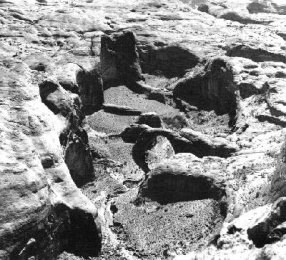
Barbara Lee 
The Geology of Rainbow Bridge Rainbow Bridge is but one of the endlessly fascinating landforms found on the Colorado Plateau and the story of its formation is an intriguing one. Natural bridges are rare, and differ from arches in that they form when a watercourse breaks through rock. Arches are far more common across the Colorado Plateau, although both are SHAPED by the same erosional processes. The Beginning The Colorado Plateau Water--the Absent Artist A Rainbow Made of Stone 
As you can see from the illustration, the force of the stream eventually cut a hole through the fin. Rainbow Bridge was created when the stream altered course and flowed directly through the opening, enlarging it. This process continues to this day, imperceptibly altering the shape of the Bridge. The same erosional forces which created the bridge will, eventually, cause its demise. Rainbow Bridge, along with the rest of the spectacular landscapes of the Colorado Plateau, will exist for only the blink of an eye in geologic time. We should consider ourselves fortunate, indeed, to be witness to these awe-inspiring formations. Let us treasure them while we can. |
Last updated: April 17, 2025
